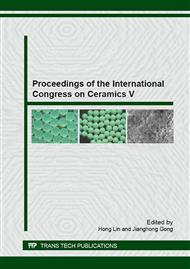p.45
p.49
p.53
p.58
p.62
p.68
p.72
p.78
p.82
Analysis of the Mechanisms of Cracking Selected Transition Metal Carbides
Abstract:
Fracture toughness is one of the basic properties that determine the usefulness of these materials for structural applications. In this work, an analysis of cracking mechanism and measuring the fracture toughness of selected carbides: NbC, TaC and ZrC were carried out. Tested materials were sintered using Spark Plasma Sintering method (SPS), at 2200 °C, under a pressure of 35 MPa. Sintering time was 5 and 30 min. Commercial powders were used, with a particle size in the range from 1 to 6 microns. The powders were sintered without the addition of sintering activators.Additionally selected physical and mechanical properties have been investigated: apparent density (Archimedes method), Young's modulus (ultrasonic) and hardness (Vickers). The cracking mechanisms analysis was carried out using Scanning Electron Microscopy (SEM). Studies have shown that the highest fracture toughness, about 5.35 MPa·m1/2, characterized tantalum carbide, sintered at 2200 °C for 5 min. TaC also had the highest resistance to the formation of chipping around the Vickers indentation.
Info:
Periodical:
Pages:
62-67
Citation:
Online since:
July 2015
Keywords:
Price:
Сopyright:
© 2015 Trans Tech Publications Ltd. All Rights Reserved
Share:
Citation:


